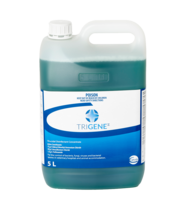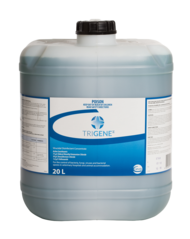
COMPOSITION
Each L contains n-alkyl dimethyl benzyl ammonium chloride 50 g, didecyl dimethyl ammonium chloride 75 g, poly (hexamethylene) biguanide hydrochloride 1 g.
Description. A noninitant, nontoxic, noncorrosive and nonhazardous bactericidal, fungicidal, virucidal, mycobacterial and sporicidal agent.
ACTIONS
TriGene disinfectant is a synergistic blend of several active ingredients. Dodecylamine sulphamate is a powerful salt developed from dodecyl amine and sulfamic acid. The salt has a high tolerance to hard water and soilage.
Poly (hexamethylene) biguanide hydrochloride is a good Grampositive biocide, with variable activity also as a virucide.
Octyldecyl dimethyl ammonium chloride is a powerful quarternary compound with antibacterial, virucidal and tuberculocidal activity at low dilutions. It is bacteriostatic in high dilutions with a very high tolerance to both hard water and organic soilage when in combination with dodecylamine sulfamate.
The activity of nonyl phenyl-w-hydroxy-poly (oxythylene) (NP9) is to act first to attack cell walls as a penetrative agent allowing the combinations of disinfectants to enter the cortex of the cell and destroy it. The secondary activity is as a surface active agent or detergent that loosens organic material into suspension in water. Ethanol acts to promote cell wall activity in particular with certain viral groups.
It is well known that the long chain quarternary compounds which possess the greatest antibacterial activity are those with at least one radical and with a C8 to C18 length carbon chain. It is also known that absorption plays an important role in the activity of disinfectant formulations. TriGene disinfectants are highly surface active and therefore readily absorbed. Because of the large specific surface of the particulate microorganisms, the first stage of germicidal activity begins with the adsorption of the disinfectant by the microbial cell. Such adsorption increases the permeability of the cell membrane, leading to the ultimate rupture and the decrease of lysine and glutamic acid. The inclusion of dodecylamine sulfamate appears to stimulate the contraction of the cytoplasm followed by complete stripping of the cell wall. A second mode of action proposed is that cell death results from inactivation of energy producing enzymes such as those concerned with glucose, succinate and pyruvate oxidase systems.
INDICATIONS
Suitable for general disinfection of all surfaces (floors and walls), kennel areas, examination tables, surgery walls, food and water bowls and bedding. May be used on rubber, vinyl and most hard surfaces, including food preparation areas.
TriGene is effective against bacteria, fungi, viruses and bacterial spores in veterinary hospitals and animal accommodation, including the following.
Bacteria. Listeria monocytogenes, Salmonella sp., legionella sp., Escherichia coli, Staphylococcus aureus, Streptococcus sp., Proteus vulgaris, Pseudomonas sp., Mycobacterium fortuitum, Bacillus sp., Clostridium sp., Campylobacter sp., Klebsiella sp., Mycobacterium tuberculosis and Bordetella bronchiseptica.
Fungi. Microsporum sp., Candida albicans, Trichophyton sp., Penicillium sp., Aspergillus niger and Saccharomyces cerevisiae.
Viruses. Parvovirus, equine herpesvirus, infectious bursal dis¬ease virus (IBD), influenza, Newcastle disease, orthopoxvirus, feline calicivirus (FCV), feline infectious peritonitis, feline panleukopenia virus and feline rhinotracheitis.
DOSAGE AND ADMINISTRATION
Diluted solution keeps for 12 months.
General disinfection of all surfaces. Dilute 1:100 for general use and intermediate risk areas. Dilute 1:50 for high risk or soiled areas.
Examination tables. Dilute 1:20 for rapid disinfection of high risk areas and consult tables.
Food and water bowls. Dilute 1:50. Clean off soil before disinfection. Rinse thoroughly before use.
Bedding and clothing. 50 mL/4 kg load. Place in conditioner dispenser of washing machine, soak for 30 mins.
Body spillages. Dilute l:50 for spillages and organic matter when risks of infection are higher.
Large animal accommodation. Dilute 1:100.
Fogging. Dilute 1:100.
PRESENTATION
Liquid: 5 L, 20 L.
STORAGE
Store below 30°C (Room Temperature). Do not store at low temperatures. Do not freeze. Store in the closed, original container in a cool, well-ventilated area. Do not store for prolonged periods in direct sunlight.
AVAILABILITY
For General Sale (APVMA 59998)
Poisons Schedule S6
WARNINGS
Contraindications Do not use for disinfection of medical, veterinary or other body contact instruments. Avoid contact with polished wood. Before use, remove animals and remove or cover all feed and water. Remove residual organic matter before disinfection. Rinse and dry surfaces before use.
Precautions Do not mix with other chemicals or detergents.
NOT TO BE USED FOR ANY OTHER PURPOSE OR IN ANY MANNER CONTRARY TO THE LABEL UNLESS AUTHORISED.
Safety directions. Harmful if swallowed. Will damage eyes. Will irritate the skin. Repeated exposure may cause allergic disorders. Avoid contact with eyes and skin. When opening the container and preparing solution, wear cotton overalls buttoned to the neck and wrist (or equivalent clothing) and elbow-length chemical resistant gloves and face shield or goggles. Wash hands after use. After each day's use, wash gloves, face shield or goggles and contaminated clothing.
First Aid. If poisoning occurs, contact a doctor or Poisons Information Centre. Phone Australia 131 126; New Zealand 0800 764 766. If swallowed, do NOT induce vomiting. Give a glass of water. If skin contact occurs, remove contaminated clothing and wash skin thoroughly. If in eyes, hold eyes open, flood with water for at least 15 minutes and see a doctor.
Disposal. Triple rinse before disposal. Add rinsings to prepared solution. Do not dispose of undiluted chemicals on site. If recycling, replace cap and return clean containers to recycler or designated collection point. If not recycling, break, crush or puncture and deliver empty packaging to an approved waste management facility. If an approved waste management facility is not available, bury the empty packaging 500mm below the surface in a disposal pit specifically marked and set up for this purpose, clear of waterways, desirable vegetation and tree roots, in compliance with relevant local, state or territory government regulations. Do not burn empty containers or product.

 Corporate Website
Corporate Website
 Africa
Africa
 Argentina
Argentina
 Asia
Asia
 Australia
Australia
 Belgium
Belgium
 Brazil
Brazil
 Bulgaria
Bulgaria
 Canada (EN)
Canada (EN)
 Chile
Chile
 China
China
 Colombia
Colombia
 Denmark
Denmark
 Egypt
Egypt
 France
France
 Germany
Germany
 Greece
Greece
 Hungary
Hungary
 Indonesia
Indonesia
 Italia
Italia
 India
India
 Japan
Japan
 Korea
Korea
 Malaysia
Malaysia
 Mexico
Mexico
 Middle East
Middle East
 Netherlands
Netherlands
 Peru
Peru
 Philippines
Philippines
 Poland
Poland
 Portugal
Portugal
 Romania
Romania
 Russia
Russia
 South Africa
South Africa
 Spain
Spain
 Sweden
Sweden
 Thailand
Thailand
 Tunisia
Tunisia
 Turkey
Turkey
 Ukraine
Ukraine
 United Kingdom
United Kingdom
 USA
USA
 Vietnam
Vietnam

